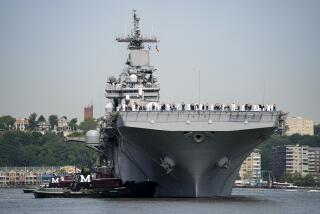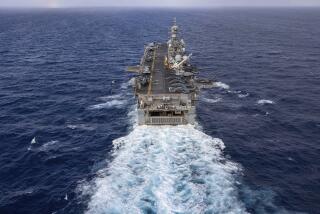THE MEDITERRANEAN SUMMIT : Talks at Sea--a Symbolic Backdrop : Logistics: Meeting aboard ship will ensure security and privacy. But it also raises the specter of seasickness.
- Share via
WASHINGTON — The decision of President Bush and Soviet President Mikhail S. Gorbachev to hold their first working meeting aboard warships at sea will immediately create a memorable and symbolic backdrop for the historic event.
The settings will dramatize the growing military-to-military contacts between the two superpowers and the two nations’ decreasing military and political rivalry.
The summit-at-sea provides the leaders with the desired security, privacy and intimacy. But it also poses a host of logistical problems unlike those of previous onshore summits, from the choice of ships to the possibility of rough water and seasickness.
Washington and Moscow have agreed to send roughly equivalent cruisers from their navies for the meetings, but the specific ships have not been named. The United States and the Soviet Union both maintain substantial fleets in the Mediterranean, including cruisers, destroyers, frigates and submarines.
The U.S. Navy also continually stations an aircraft carrier in the region, but the Soviets have no equivalent ship.
The obvious U.S. choice is the cruiser Belknap, flagship of the U.S. 6th Fleet, which is permanently based at Gaeta, Italy. As the fleet’s flagship, it has quarters fit for a senior naval commander, including a wood-paneled conference room and elegant wardrooms and staterooms.
But the Administration may be reluctant to use the Belknap, since its name is associated with a Nov. 22, 1975, incident in which the cruiser collided with the carrier John F. Kennedy off Sicily, killing eight American sailors and injuring 46.
Navy spokesman Lt. Bruce Cole said that three U.S. cruisers would be on station in the Mediterranean in time for the Dec. 2-3 summit: the Aegis-class cruiser Yorktown and the guided-missile cruisers Wainwright and Harry E. Yarnell.
Each is about 550 feet long, displacing 7,000 to 9,000 tons. The Soviet navy has several equivalent classes of warships, including the new Kara-class cruisers.
Also still to be decided is whether the discussions will take place while the ships are under way or at anchor.
Landing a helicopter on a moving warship is a tricky business, even in good weather, naval experts say. And boarding from a smaller launch can also be harrowing in high winds and heavy seas, they said.
Retired Adm. Gene LaRoque of the pacifist Center for Defense Information suggested that the meeting likely will take place in a neutral port, such as the island of Malta, or as the ships are lashed together in international waters.
There is scant historical precedent for a shipboard summit. The last time an American President met a foreign leader aboard a warship was during World War II.
President Franklin D. Roosevelt met British Prime Minister Winston Churchill aboard the British battleship Prince of Wales off the coast of Newfoundland in August, 1941.
More to Read
Sign up for Essential California
The most important California stories and recommendations in your inbox every morning.
You may occasionally receive promotional content from the Los Angeles Times.










